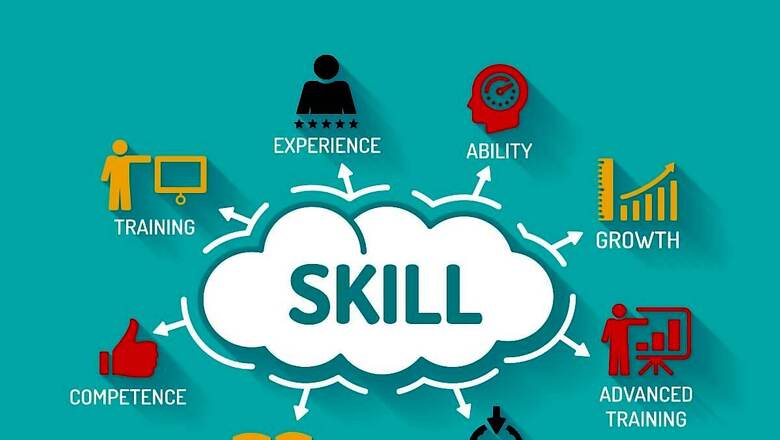
views
India has surpassed China as the world’s most populous country in demographic composition, with a staggering 65 percent working-age population having an average age of 28.4 years. This population has the potential to propel the nation towards remarkable socio-economic progress and has the ability for transformative global impact. To reap the benefit of demographic advantage, it is imperative to equip our working population with employable skills and knowledge that meet the requirements of the globalised labour market. Skill development in educational institutions is the critical enabler for improving employment outcomes and higher productivity leading to faster and more sustainable economic growth.
There is a significant gap between the skills imparted in educational institutions in India and the skills required for jobs. The International Labour Organisation (ILO) has projected that India will face a 29 million skill deficit by 2030. Still, India’s education system is unable to provide the necessary skills to its growing workforce. Many young people lack the required qualifications and vocational training to find suitable jobs.
India Skills Report 2023 reveals a rise in the employability of 52.8 percent with women and men at 47.2 percent. Women surpassed men in employability because, in the post-Covid era, nursing, beauty and wellness and other soft skills showed the highest employability rates among women. Not only for women but for men also, the beauty and wellness sector has unlimited potential in terms of domestic and global markets. The beauty and wellness market in India was valued at Rs 901.07 billion in 2018 and is forecast to reach Rs 2,463.49 billion by 2024, expanding at a compound annual growth rate (CAGR) of around 18.40 percent during 2019-2024.
There is an extra advantage in the employability of women because the companies have also adopted new recruitment strategies centred around soft skills like communication, teamwork, and emotional intelligence. However, institutes haven’t adopted the norm of educating their students on as of now employable skills, thus hurting the freshers entering the job market.
The Department of School Education and Literacy is executing the vocationalisation of School Education initiative under ‘Samagra Shiksha’ (holistic education) to integrate vocational education with general academics in secondary and senior secondary schools. The goal is to enhance youths’ employability, entrepreneurial skills, work environment exposure, and career awareness. The ideal employee in the 21st century embodies a diverse set of skills, including a perfect blend of technical and soft skills.
India has a unique opportunity to capitalise on its 48 percent population under the age of 25, and the working-age population is forecast to hit more than one billion in the current decade. An IMF report suggests that demographic dividend could add up to two percentage points to per capita GDP growth per annum. But the question remains, how can India capitalise on its demographic dividend?
Developed countries like Singapore and South Korea demonstrate the potential for leveraging the demographic dividend to achieve remarkable economic growth by implementing forward-thinking policies and programs that empower the youth in education and skill development. It is crucial to note, however, that these dividends are not guaranteed and hinge on the adoption of effective policies within this golden window of opportunity.
Various job roles across multiple sectors are included in these modules to cater to students’ aptitudes and aspirations. Apart from this, under the Skill India Mission, the Ministry of Skill Development and Entrepreneurship offers skill training through schemes like PMKVY, JSS, NAPS, and CTS via ITIs. These demand-driven initiatives aim to improve youth employability by continuously adding industry-relevant courses. Unfortunately, this is not enough, as not all schools offer this.
The world of work is changing faster than the workforce, with technological developments, automation, changes in consumer behaviour, and widespread remote working patterns rapidly changing how and where we work.
India should further strengthen its Technical and Vocational Education & Training (TVET) programs. For instance, Finland’s TVET program is known for its high-quality education, strong connection with industry needs, and emphasis on practical skills. One of the critical aspects of Finland’s TVET system that India can learn from is its strong collaboration between educational institutions, the private sector, and the government. This cooperation ensures that the curriculum and training programs are tailored to meet the current and future needs of the labour market, thereby enhancing the employability of graduates. India can benefit from adopting a similar approach, encouraging stronger ties between educational institutions and industry players to develop curricula that are aligned with market demands.
The workforce stays competitive and adapts to the rapidly changing demands of the global economy by promoting a culture of continuous learning and up-skilling, supported by government policies and incentives. This would not only help to bridge the skill-employability gap but also enable India’s workforce to remain agile and prepared for the ever-evolving job market. Skillfully leveraging the demographic dividend can pave the way for elevated living standards and sustain the country’s economic growth.
The writer is co-founder and MD, of Orane International, a training partner with the National Skill Development Corporation(NSDC), Network Member, of India International Skills Centres, an initiative of GoI. Views expressed are personal.


















Comments
0 comment